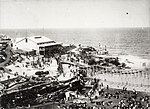Waverley Council

Waverley Council is a Local government area in the eastern suburbs of Sydney, in the state of New South Wales, Australia. First incorporated on 16 June 1859 as the Municipality of Waverley, it is one of the oldest-surviving local government areas in New South Wales. Waverley is bounded by the Tasman Sea to the east, the Municipality of Woollahra to the north, and the City of Randwick in the south and west. The administrative centre of Waverley Council is located on Bondi Road in Bondi Junction in the Council Chambers on the corner of Waverley Park. The elected Waverley Council is composed of twelve councillors elected proportionally across four wards, each electing three Councillors, and the most recent election was held on 4 December 2021. The current mayor of Waverley Council since September 2019 is Councillor Paula Masselos of Lawson Ward, a member of the Labor Party.
Excerpt from the Wikipedia article Waverley Council (License: CC BY-SA 3.0, Authors, Images).Waverley Council
Darling Street, Sydney Bronte
Geographical coordinates (GPS) Address Nearby Places Show on map
Geographical coordinates (GPS)
| Latitude | Longitude |
|---|---|
| N -33.9 ° | E 151.26666666667 ° |
Address
Darling Street
Darling Street
2024 Sydney, Bronte
New South Wales, Australia
Open on Google Maps









